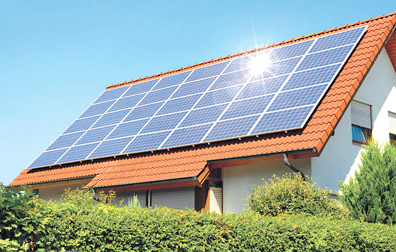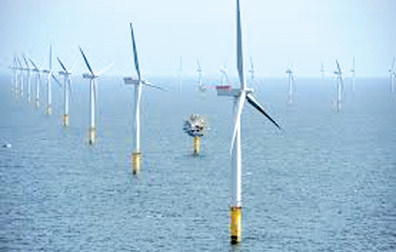|
Power hunger - the energy future:
Looking to Sun, wind and water
by Maneshka Borham and Krishani Samaraweera
Renewable energy is the only option to overcome power cuts and
blackouts. Chairman of the Sri Lanka Sustainable Energy Authority(SLSEA)
Keerthi Wickramaratne was optimistic that the only way out of this issue
was to make a gradual switch to renewable sources of energy.
 |
|
Solar panels on the roof -
Flickr |
He said although initial costs in setting up renewable energy power
plants were high, it is as costly as some claim. However, he agreed that
an immediate switch was not possible. "Nevertheless, it is feasible
through upgrading our systems" he said.
Wickramaratne said with assistance from developed countries, a switch
to renewable energy was a possibility. "Computerised systems and other
costs will arise but switching to renewable sources was a positive move,
he said.
"Solar and wind power were the best options for renewable energy
sources in Sri Lanka. Solar power is a good option" he said.
"If we increase the use of solar power, then costs will decrease,
while in the long-term it will be cheaper and most importantly, it is
environment-friendly" he said. However, Wickramaratne said storage of
solar power might be a problem due to various issues.
Non-conventional
He said offshore sea currents were a viable option "But we have not
yet developed it to be used as a renewable energy source," he added.
While options for renewable energy are many, at present power
generation through non-conventional renewable energy such as solar
according to the Central Bank Report remains at 9.9 percent unchanged
from the previous year and only generates a mere 1217 GWh annually.
With Sri Lanka facing a number of blackouts last month due to various
technical reasons the Ceylon Electricity Board (CEB) faced, and the
coal- powered Norochcholai power plant failing yet again, concerns among
the public and the authorities were raised on the reliability of the
national power supply, while alternative energy is a much-discussed
topic.
According to the Central Bank Report of 2014, the total generation of
electricity in Sri Lanka has increased by 3.9 per cent to 12,357 GWh up
from 11,898 GWh in 2013. Currently while 69 per cent of the power supply
is generated by the CEB, this amount keeps dropping annually, with the
remainder being purchased from independent power suppliers.
Chairman of the Ceylon Electricity Board(CEB) Anura Wijepala said
over 50 percent of Sri Lanka's power supply was through renewable
sources, with hydro power being the main source which provides up to
50.3 percent of the electricity generated.
 |
|
Windpower moves offshore
- popsci.com |
"There are only a few countries which generate power from renewable
energy and we are one such" he said, adding that in the modern day, not
even developed countries produce energy from such sources. According to
Wijepala, countries such as Nepal and Bhutan generate electricity
through hydropower and provided the facility to a select number of
consumers and not to the whole country" he said.
Sustainable
The Central Bank Report points out that hydro power generation during
the year became difficult, due to the prevailing drought in Sri Lanka,
once again proving without any doubt, the importance of cheap and
alternative energy options that can provide a more sustainable power
supply, while meeting the demand of its 5.7 million consumers in the
island.
"Renewable energy was of significant importance in the modern day,"
Strategic Enterprise Management Agency Asoka Abeygunawardana said. Due
to the environmental impact, fossil fuel use should be phased out by
2050. Coal power has no future and does not serve Sri Lanka any purpose
to set up fossil fuel infrastructure to generate power, he said.
"Economic costs, environmental costs and social costs of imported
coal were expensive whereas other renewable sources were much cheaper,
making renewable energy the best alternative for the country," he said.
Minister of Finance Ravi Karunanayake noted in his 2016 Budget speech
renewable energy was one of the key areas of potential investment of
over Rs 2 billion. The Minister encouraged homeowners to opt for solar
power, with costs being a qualified deduction for tax purposes while
also emphasising the potential of non-conventional renewable energy,
such as wind and solar.
Minister Karunanayake encouraged the CEB to partner with private
companies to harness such sources to provide cheaper energy to consumers
and meet the domestic requirement.
Also on a positive note, the Central Bank Report stated that 12 mini
hydro power projects, three wind power plants, one biomass power plant
and one dendro power project were commissioned, showing attempts to move
towards renewable energy. The CEB has also signed contracts for 42
non-conventional renewable energy projects.
The Sri Lanka Sustainable Energy Authority identified potential wind
power in Mannar being able to generate wind power of up to 375 MW.
With these steps bringing hope, the question remains as to whether
Sri Lanka could switch to renewable energy, which experts claim to be
the answer to the energy woes in Sri Lanka.
The CEB Chairman was hopeful and said, "It is 100 percent feasible"
adding that a switch to renewable energy was possible albeit not
immediately, if Sri Lanka looks towards ways of storing the energy.
This, he said, was an expensive exercise. |

